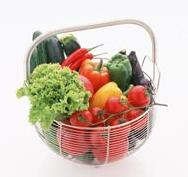 Final post of the series on composting. This time, let's see in more details how to create compost for growing vegetables naturally. Contrary to what many gardening books advocate, compost alone can be totally sufficient for vegetable plants, provided you recycle all your organic garbage and use some external materials from time to time, such as manure.
Final post of the series on composting. This time, let's see in more details how to create compost for growing vegetables naturally. Contrary to what many gardening books advocate, compost alone can be totally sufficient for vegetable plants, provided you recycle all your organic garbage and use some external materials from time to time, such as manure.First, decide if you want to make your compost in a dedicated bin, or just make a compost pile in a corner of your garden. Bins have the advantage of keeping the materials in a confined space, in addition to being more esthetic for most people. Some bins have also built-in systems to turn the compost and allow for a better circulation of air. If you don't want to spend on a bin - which may be a bit expensive for some models - you can just make a pile. In this case, it should be at least one square meter large, and you should be careful putting large chunks of material - such as branches - at the base of the pile to allow for air circulation and evacuation of excess moisture. Air circulation is crucial for the success of your composting, as it is air which fuels the aerobic microorganisms responsible for the breakdown process in composting. Excess moisture is bad also for the same reason, and will promote undesirable anaerobic organisms.
The compost pile should then be made of food scraps (except all animal scraps such as meat, bone or fat), vegetable peels and waste, egg shells, rotten fruits and vegetables, grass clippings and leaves, coffee and tea grounds, shredded papers, and manure (from herbivorous animals) if you have access to it. The important thing is to not have large clumps of a single type of material, but rather a succession of layers with different materials. If a piece is too large, try to reduce it in smaller pieces, for instance by shredding your papers. Then, the best is to alternate "hot" and "cold" materials. Hot materials are basically fresh materials - kitchen scraps, fresh vegetable peels, fresh grass clippings... - while cold materials have already been transformed in some way - like papers, dry grass clippings, etc.
Your compost pile should start to warm up after 24 hours, as a result of microorganism activity. Remember that this is an "aerobic" process, fueled by oxygen. Your compost pile should therefore be aerated, and not look like a pile of compacted garbage and moisture like what you have in usual trash bins. The heating will increase activity, until temperature stabilizes. This is the gauge of the process, and if it starts cooling down, it means that something is wrong. Check previous recommendations to find the problem.
Once a week, rotate the pile in order to homogenize the content and ensure that all parts are being broken down. The compost is ready when all the content is nearly homogenous and no longer identifiable. It usually takes between 4 and 8 weeks, depending on the quality of the initial material and on the conditions. Then you can use it freely for growing vegetables in your garden, which should eliminate the need for any chemical fertilizer.
Photo by Watt Dabney





